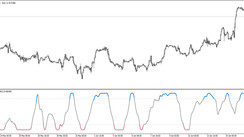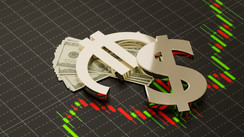Last Tuesday, the Australian dollar weakened significantly, while the AUD / USD pair dropped 57 points. At the same time, the volatility in the pair reached 90 points on Tuesday. On that day, a meeting of the Reserve Bank of Australia was held, at which its leaders decided to leave the current course of monetary policy unchanged (the interest rate, like the yield on three-year government bonds, remained at 0.1%).
Central Bank Governor Philip Lowe again said that despite the rapid economic recovery, the conditions for rate hikes will not be created soon.
Although the bank raised its forecast for GDP growth for this year to 4.75% from 3.5%, and lowered its forecast for the unemployment rate to 5.0% from 6.0%," the RBA will not raise the key rate until real inflation is firmly in the target range of 2% -3%", Lowe said in a statement after the meeting. In his opinion, "for this to happen, a strengthening of the labor market is necessary, which will provide significantly faster wage growth than now. This is unlikely to happen before 2024".
Yesterday the Australian dollar regained a significant part of the positions lost on Tuesday, while the AUD / USD pair rose 43 points, returning to the mark of 0.7747, and today the Australian dollar received another blow, this time from China, which is a strategic partner of Australia.
Beijing said this morning that it intends to "indefinitely suspend" all communication in the Sino-Australian Strategic Economic Dialogue.
The National Development and Reform Commission of the People's Republic of China said that the decision was made in response to "the implementation by the Australian authorities of a number of measures that interfere with the normal interaction" of the two countries. The steps were taken (by Australia) "within the logic of the Cold War and ideological discrimination", the commission said in a statement.
Relations between the two countries deteriorated last year after Australian authorities called for an investigation into the causes of the coronavirus infection, indirectly and unsubstantiatedly blaming China for the spread of the coronavirus around the world, which angered Beijing. China has raised duties on imports of Australian-made goods and urged its citizens to stop traveling to the country.
Events developing in the negative direction signal intensified diplomatic tensions between Australia and China, which accounted for almost 65% of Australia's total foreign trade turnover in 2020 in counter-trade relations. If we consider that Australia's share in the total foreign trade turnover of the PRC is no more than 6%, then the break (or suspension) of the strategic partnership between these countries will cause significant damage to the Australian economy.
After today's announcement of the decision of the National Development and Reform Commission of the People's Republic of China, the Australian dollar weakened sharply again, and the AUD / USD pair fell by more than 50 points, testing the psychologically significant support level of 0.7700.
During the entire Asian trading session, the AUD / USD pair recovered again, returning to the bull market zone above 0.7741 level (see Technical analysis and trading recommendations). At the time of publication of this article, the AUD / USD pair remains in the zone above the support level of 0.7741, nevertheless maintaining a tendency to develop upward dynamics.
Now, market participants trading AUD will be looking at the RBA's monetary policy commentary on Friday (published at 01:30 GMT), which provides an overview of economic and financial conditions and an assessment of risks to financial stability and sustainable economic growth. The commentary is a kind of guideline for defining the RBA's monetary policy plans. A tougher stance on the RBA's monetary policy is seen as positive and strengthens the Australian dollar, while a more cautious stance is seen as negative for the AUD.
"Inflation and wages are expected to accelerate, but this is likely to be gradual and moderate", Lowe said Tuesday. It is likely that the comments and the quarterly statement on the RBA's monetary policy will contain more complete information and more detailed forecasts.
Meanwhile, the US dollar declines again on Thursday, responding to the downward trend in the yield curve of US government bonds and despite strong US macro statistics released on Wednesday.
Thus, the ADP report indicated an increase in employment in the private sector in April from 565 to 742 thousand (the forecast was +800 thousand). Markit PMI for April also supported the dollar, recording an increase from 63.1 to 64.7 points, while the composite PMI rose from 62.2 to 63.5 points. Corresponding PMI from ISM also came out high, albeit below forecast (62.7 vs. 63.7 forecast).
In addition to the Bank of England meeting today, investors will also be watching the publication (at 12:30 GMT) of the weekly data from the US labor market. A decrease in the number of initial applications for unemployment benefits is expected (from 553 thousand a week earlier to 540 thousand). This is also a positive factor for the USD, all the more important ahead of the publication on Friday (at 12:30 GMT) of the monthly official data from the US labor market. A significant improvement in the indicators for April is expected.





